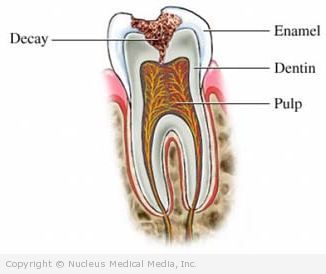(Cavities; Dental Caries; Dental Decay)
Tooth decay – Definition
Tooth decay is the destruction of tooth material, which includes:
- Enamel — the hard outer surface of the tooth
- Dentin — the second softer layer beneath the enamel
- Pulp — the inside of the tooth containing the nerve and blood supply
- Root — the area of the tooth anchoring it in the bone
Tooth decay – Causes
Everyone has bacteria in their mouths. The bacteria eats sugars that are left on the tooth which then creates acid. The acid and the bacteria form plaque on the teeth. This plaque clings to your teeth. It hold the acid to the tooth. The acid wear away the tooth. Over time, the acid can lead to tooth decay.
Tooth decay – Risk Factors
Everyone has the chance to develop tooth decay. Factors that may increase your risk of cavities include:
- Snacking
- Having poor dental hygiene
- Having high numbers of bacteria in the mouth
- Having an insufficient amount of fluoride (Some communities in the United States add fluoride to the drinking water.)
- Taking medicine that contains sugar or causes dry mouth
- Eating a diet high in sugar
- Being malnourished (eg, vitamin and mineral deficiencies)
- Having certain conditions that decrease the flow of saliva in the mouth (eg, Sjogren’s syndrome or Heartburn)
- For children: having caregivers or siblings with severe dental caries
Babies are also at risk for developing cavities. Habits that can increase the risk include giving a bottle between regular feedings or while in bed at night.
Tooth decay – Symptoms
Symptoms include:
- Tooth sensitivity to hot or cold
- Tooth discomfort after eating
- Darkening of the tooth surface
- Bad breath or a foul taste in the mouth
- Throbbing, lingering pain in tooth
Tooth decay – Diagnosis
Tooth decay is diagnosed over a period of time. This involves clinical examination as well as x-rays.
A dentist checks for tooth decay by:
- Asking about pain in the teeth
- Visually inspecting the surface of the teeth
- Probing teeth with dental instruments to check for:
- Sensitivity
- Pain
- Softness
- Surface defects
- Taking x-rays of teeth
Tooth decay – Treatment
Sometimes tooth decay will repair itself. This is most likely if it is caught early.
Treatment for more severe decay includes:
Fillings
When decay reaches the dentin, your dentist will treat it by:
- Numbing the tooth and surrounding tissue area
- Removing the decay with instruments
- Filling the hole with a dental filling; the filling can be silver or tooth colored
Root Canal
Tooth decay that reaches the pulp and/or root of the tooth is treated with a root canal:
- The tooth is numbed and a hole is drilled through the top of the tooth.
- Pus and dead tissue are removed from the tooth.
- The inside of the tooth and the root (nerve) canals are cleaned and filled with a permanent filling.
- The root (nerve) canal is sealed.
- A crown is placed on the tooth to protect it.
Tooth Extraction (Removal)
The tooth may need to be removed if:
- Tooth decay and/or tooth infection is too extensive for filling or root canal.
- A break or crack in the tooth that has allowed for decay is too severe to be repaired.
- An extensive infection exists between the tooth and gum.
If the tooth is removed, it will be replaced with:
- A partial bridge
- A denture
- A tooth implant
If you are diagnosed with tooth decay, follow your dentist’s instructions.
Tooth decay – Prevention
Measures that help prevent and stop tooth decay include:
- Proper dental hygiene, including:
- Brushing teeth with fluoride toothpaste after meals or at least twice per day
- Daily flossing between teeth and gums—Bacteria living between the teeth can only be removed with floss or interdental cleaners.
- Getting regular dental check-ups and teeth cleaning
- Limiting the amount of sugar and carbohydrates you eat and drink, including:
- Honey
- Sodas
- Candy
- Cakes
- Cookies
- Other sweets
- Rinsing your mouth with water after eating sugars
- Replacing your toothbrush every 3 to 4 months
- Avoiding sugar-containing drinks (including fruit juices), especially in baby bottles
- Chewing gum with xylitol or sorbitol (may reduce your risk of developing cavities)
Talk to your dentist about the use of a sealant. This is a protective plastic covering. It is applied to the chewing surfaces of teeth. Sealants usually last anywhere from 5-15 years.
Prevention is particularly important for children. Supplemental fluoride in early childhood can prevent early decay. Most local water supplies have fluoride. Fluoride can also be applied to permanent teeth as a long acting varnish. Re-varnishing is usually necessary at least twice yearly.

